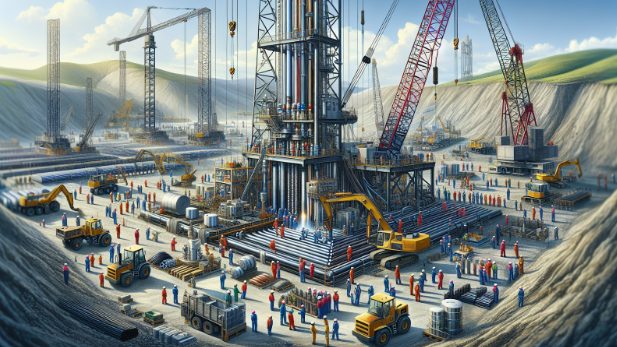
Introduction
Well drilling is an essential process that allows us to access groundwater, oil, and gas resources. However, the use of well drilling rigs can have significant impacts on the ecosystems in which they operate. In this comprehensive guest post, we will explore the various ways in which well drilling rigs can affect the environment and discuss the measures that can be taken to mitigate these impacts.
Types of Well Drilling Rigs
Rotary Drill Rigs
Rotary drill rigs are the most widely used type of well drilling rig. They consist of a rotating drill bit attached to a drill string, which is powered by a motor. As the drill bit rotates, it cuts through rock and soil, creating a borehole. Rotary drill rigs can be used for a variety of applications, including water well drilling, oil and gas exploration, and geothermal well drilling.
Auger Drill Rigs
Auger drill rigs use a helical screw, known as an auger, to remove soil and create a borehole. The auger is rotated by a motor, which causes it to dig into the ground and bring soil to the surface. Auger drill rigs are commonly used for shallow well drilling and for drilling in unconsolidated soil formations.
Cable Tool Drill Rigs
Cable tool drill rigs, also known as percussion drill rigs, rely on a heavy bit that is repeatedly dropped into the borehole to crush rock and create a well. The bit is attached to a cable, which is raised and lowered by a motor. Cable tool drill rigs are less common than rotary and auger drill rigs, but they can be effective in certain applications, such as drilling through hard rock formations.
Environmental Impacts of Well Drilling Rigs
Well drilling rigs can have a range of environmental impacts, depending on the type of rig, the location of the drilling site, and the measures taken to mitigate these impacts. Some of the most significant environmental considerations associated with well drilling include:
Land Disturbance
The construction of well drilling sites can result in significant land disturbance, including the removal of vegetation, soil compaction, and the creation of access roads. This can lead to erosion, habitat loss, and fragmentation of ecosystems.
Air Pollution
Well drilling rigs can generate significant amounts of air pollution, primarily from the combustion of fossil fuels used to power the rigs. This can include emissions of nitrogen oxides, sulfur dioxide, particulate matter, and volatile organic compounds, which can contribute to air quality problems and have negative impacts on human health and the environment.
Noise Pollution
Well drilling rigs can be noisy, with sound levels often exceeding 100 decibels. This can have negative impacts on wildlife, particularly species that rely on acoustic communication, such as birds and bats. Noise pollution can also be a nuisance for nearby communities and can have negative impacts on human health.
Water Contamination
Well drilling can pose risks to groundwater and surface water resources, particularly if proper precautions are not taken to prevent contamination. This can include the accidental release of drilling fluids, which can contain a range of chemicals and additives, as well as the potential for methane and other gases to migrate into water supplies.
Habitat Fragmentation
The construction of well drilling sites and associated infrastructure, such as access roads and pipelines, can fragment habitats and create barriers to wildlife movement. This can have negative impacts on species that require large, contiguous areas of habitat, such as wide-ranging mammals and migratory birds.
Invasive Species
The movement of well drilling rigs and associated equipment between sites can facilitate the spread of invasive species, particularly plants and insects. This can have negative impacts on native ecosystems and can be difficult and costly to control once established.
Mitigation Measures
There are a range of measures that can be taken to mitigate the environmental impacts of well drilling rigs. These include:
Site Selection
Careful site selection can help to minimize the impacts of well drilling on sensitive ecosystems and wildlife habitats. This may involve avoiding areas with high conservation value, such as wetlands, riparian areas, and critical habitat for threatened or endangered species.
Best Management Practices
The implementation of best management practices can help to reduce the environmental impacts of well drilling. This may include measures such as using closed-loop drilling systems to minimize water use and waste, implementing erosion and sediment control measures, and properly managing and disposing of drilling fluids and other wastes.
Noise Reduction
Noise reduction measures, such as using sound barriers and mufflers on drilling equipment, can help to minimize the impacts of noise pollution on wildlife and nearby communities.
Emissions Control
The use of emissions control technologies, such as catalytic converters and diesel particulate filters, can help to reduce air pollution from well drilling rigs. In addition, the use of alternative fuels, such as natural gas or biodiesel, can help to reduce emissions of certain pollutants.
Habitat Restoration
Habitat restoration measures, such as revegetation and soil stabilization, can help to minimize the long-term impacts of well drilling on ecosystems. This may involve the use of native plant species and the creation of wildlife corridors to facilitate animal movement.
Monitoring and Adaptive Management
Regular monitoring of well drilling sites can help to identify and address environmental impacts as they occur. Adaptive management approaches, which involve adjusting management practices based on monitoring results, can help to ensure that mitigation measures are effective and that environmental impacts are minimized over time.
Regulatory Framework
The environmental impacts of well drilling are regulated by a range of federal, state, and local laws and regulations. These may include:
National Environmental Policy Act (NEPA)
NEPA requires federal agencies to assess the environmental impacts of proposed actions, including well drilling projects on federal lands. This may involve the preparation of an environmental assessment or environmental impact statement, which must consider the potential impacts of the project on ecosystems, wildlife, and other resources.
Clean Water Act (CWA)
The CWA regulates the discharge of pollutants into waters of the United States, including wetlands and streams. Well drilling projects that involve the discharge of drilling fluids or other pollutants may require a permit under the CWA.
Endangered Species Act (ESA)
The ESA requires federal agencies to ensure that their actions do not jeopardize the continued existence of threatened or endangered species or destroy or adversely modify their critical habitat. Well drilling projects that may affect listed species or their habitat may require consultation with the U.S. Fish and Wildlife Service or the National Marine Fisheries Service.
State and Local Regulations
Many states and local governments have their own regulations governing well drilling and related activities. These may include requirements for permitting, site selection, drilling practices, and environmental protection measures.
Conclusion
Well drilling is an essential activity that allows us to access important resources, such as water, oil, and gas. However, the use of well drilling rigs can have significant environmental impacts, ranging from land disturbance and air pollution to water contamination and habitat fragmentation.
To minimize these impacts, it is important to implement a range of mitigation measures, such as careful site selection, best management practices, noise reduction, emissions control, habitat restoration, and monitoring and adaptive management. In addition, well drilling activities are subject to a range of federal, state, and local regulations that are designed to protect the environment and public health.
By taking a proactive approach to environmental protection and complying with applicable regulations, well drilling operators can help to ensure that their activities are sustainable and minimize negative impacts on ecosystems and communities.
Source: Explore





